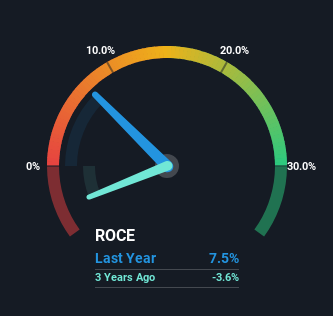- France
- /
- Hospitality
- /
- ENXTPA:VAC
We Like These Underlying Return On Capital Trends At Pierre et Vacances (EPA:VAC)

What trends should we look for it we want to identify stocks that can multiply in value over the long term? Firstly, we'd want to identify a growing return on capital employed (ROCE) and then alongside that, an ever-increasing base of capital employed. Put simply, these types of businesses are compounding machines, meaning they are continually reinvesting their earnings at ever-higher rates of return. So when we looked at Pierre et Vacances (EPA:VAC) and its trend of ROCE, we really liked what we saw.
Return On Capital Employed (ROCE): What Is It?
If you haven't worked with ROCE before, it measures the 'return' (pre-tax profit) a company generates from capital employed in its business. To calculate this metric for Pierre et Vacances, this is the formula:
Return on Capital Employed = Earnings Before Interest and Tax (EBIT) ÷ (Total Assets - Current Liabilities)
0.075 = €225m ÷ (€4.4b - €1.3b) (Based on the trailing twelve months to September 2023).
Thus, Pierre et Vacances has an ROCE of 7.5%. Even though it's in line with the industry average of 7.3%, it's still a low return by itself.
See our latest analysis for Pierre et Vacances

In the above chart we have measured Pierre et Vacances' prior ROCE against its prior performance, but the future is arguably more important. If you'd like to see what analysts are forecasting going forward, you should check out our free analyst report for Pierre et Vacances .
How Are Returns Trending?
Even though ROCE is still low in absolute terms, it's good to see it's heading in the right direction. The data shows that returns on capital have increased substantially over the last five years to 7.5%. The amount of capital employed has increased too, by 343%. So we're very much inspired by what we're seeing at Pierre et Vacances thanks to its ability to profitably reinvest capital.
In another part of our analysis, we noticed that the company's ratio of current liabilities to total assets decreased to 31%, which broadly means the business is relying less on its suppliers or short-term creditors to fund its operations. So shareholders would be pleased that the growth in returns has mostly come from underlying business performance.
The Key Takeaway
In summary, it's great to see that Pierre et Vacances can compound returns by consistently reinvesting capital at increasing rates of return, because these are some of the key ingredients of those highly sought after multi-baggers. Although the company may be facing some issues elsewhere since the stock has plunged 70% in the last five years. In any case, we believe the economic trends of this company are positive and looking into the stock further could prove rewarding.
On a separate note, we've found 1 warning sign for Pierre et Vacances you'll probably want to know about.
While Pierre et Vacances may not currently earn the highest returns, we've compiled a list of companies that currently earn more than 25% return on equity. Check out this free list here.
New: Manage All Your Stock Portfolios in One Place
We've created the ultimate portfolio companion for stock investors, and it's free.
• Connect an unlimited number of Portfolios and see your total in one currency
• Be alerted to new Warning Signs or Risks via email or mobile
• Track the Fair Value of your stocks
Have feedback on this article? Concerned about the content? Get in touch with us directly. Alternatively, email editorial-team (at) simplywallst.com.
This article by Simply Wall St is general in nature. We provide commentary based on historical data and analyst forecasts only using an unbiased methodology and our articles are not intended to be financial advice. It does not constitute a recommendation to buy or sell any stock, and does not take account of your objectives, or your financial situation. We aim to bring you long-term focused analysis driven by fundamental data. Note that our analysis may not factor in the latest price-sensitive company announcements or qualitative material. Simply Wall St has no position in any stocks mentioned.
About ENXTPA:VAC
Pierre et Vacances
Engages in the property development and tourism businesses in Europe and internationally.
Moderate growth potential low.
Similar Companies
Market Insights
Community Narratives



